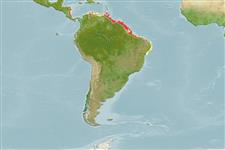Common names from other countries
Environment: milieu / climate zone / depth range / distribution range
Ecologia
marinhas; estuarina demersal; intervalo de profundidade 1 - 36 m (Ref. 13608). Tropical; 16°N - 14°S, 87°W - 34°W
Western Central Atlantic: Honduras to Salvador (Bahia) in Brazil.
Length at first maturity / Tamanho / Peso / Idade
Maturity: Lm 20.0 range ? - ? cm
Max length : 57.0 cm TL macho/indeterminado; (Ref. 3273); common length : 35.0 cm TL macho/indeterminado; (Ref. 3273); peso máx. Publicado: 2.3 kg (Ref. 5217)
Espinhos dorsais (total) : 3; Raios dorsais moles (total) : 28 - 30; Espinhos anais: 0; Raios anais moles: 25 - 27. Supraorbital and interorbital region smooth, without any filament; scaled area on head extending to middle of eye and opercle spine; 9 discrete pores on inner face of pectoral fin; body brown, with black spots and saddle-shaped blotches (Ref. 13608).
Mainly in brackish water (Ref. 5217). Found on sandy-muddy bottoms in shallow warm water. Not so active, lingers over the substrate disguised. Feeds on small gastropod mollusks, crustaceans like crabs (Calappidae, Portunidae, Xanthidae, etc.), shrimps (Penaeidae, Palaemonidae, Alphaeidae, etc.) and fishes. Females are mature at around 20 cm length, males at 25 cm. Spawns 400 to 500 eggs, with a size of 4 to 5 mm (Ref. 35237). Marketed fresh.
Life cycle and mating behavior
Maturities | Reprodução | Spawnings | Egg(s) | Fecundities | Larvas
Collette, B.B., 1978. Batrachoididae. In W. Fischer (ed.) FAO species identification sheets for fishery purposes. West Atlantic (Fishing Area 31), Volume 1. FAO, Rome. (Ref. 3273)
Categoria na Lista Vermelha da IUCN (Ref. 130435)
CITES (Ref. 128078)
Not Evaluated
Ameaça para o homem
Harmless
Utilização humana
Pescarias: espécies comerciais; Aquário: Espécies comerciais
Ferramentas
Relatórios especiais
Descarregue XML
Fontes da internet
Estimates based on models
Preferred temperature (Ref.
115969): 27.1 - 28.3, mean 27.6 (based on 300 cells).
Phylogenetic diversity index (Ref.
82804): PD
50 = 0.5020 [Uniqueness, from 0.5 = low to 2.0 = high].
Bayesian length-weight: a=0.00776 (0.00485 - 0.01241), b=3.15 (3.01 - 3.29), in cm Total Length, based on LWR estimates for this species & (Sub)family-body (Ref.
93245).
Nível Trófico (Ref.
69278): 3.7 ±0.62 se; based on food items.
Resiliência (Ref.
120179): Baixo, tempo mínimo de duplicação da população 4,5 - 14 anos (Preliminary K or Fecundity.).
Fishing Vulnerability (Ref.
59153): Moderate vulnerability (43 of 100).
